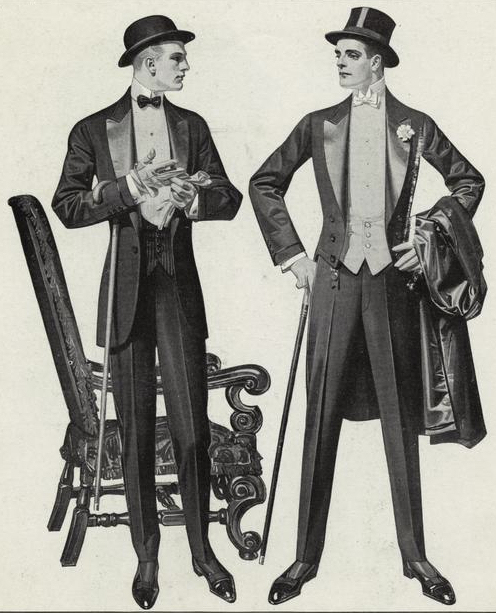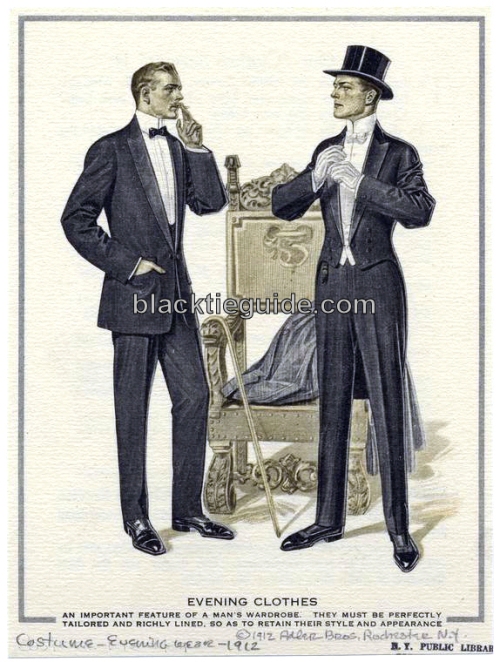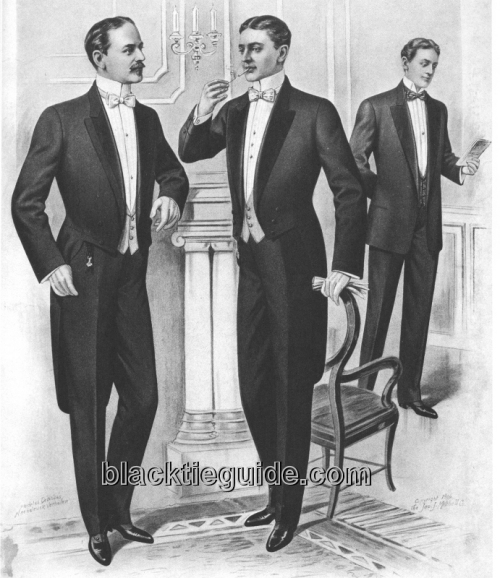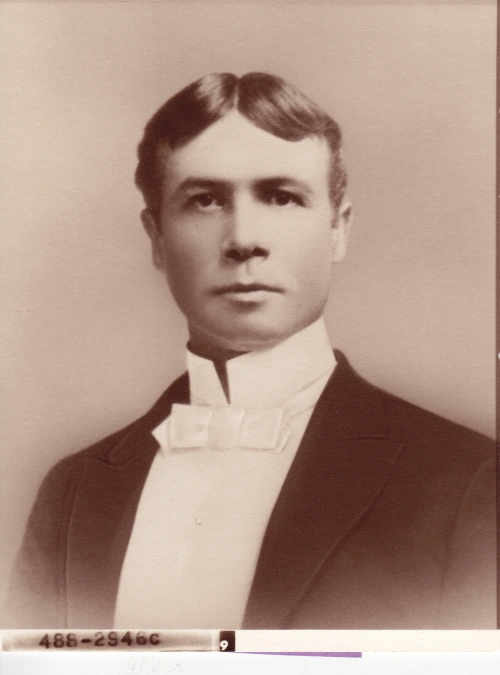Here is a lovely portrait of a Mr. William Ware, my friend Mary’s Virginia relative. He sits nice and tall, shoulders back, and chest slightly puffed out. He looks very dapper in his fancy, upper class suit. This guy shows all the signs of being an Edwardian gentleman, effectively dating this photo between 1900 and 1916.
William wears the formal attire seen at a Victorian or Edwardian after-six formal affair. Considered White Tie because of his white bow tie, this formal attire was a strict uniform, with little variation, or else it was seen as insulting to the host or other guests. In addition to the white bow tie, William wears a white detachable stand up Imperial collar, immensely starched without the ‘wings’ seen in the late 19teens and onwards of collared formal shirts.

The man on the right illustrates the ‘winged’ collar in his White Tie formal wear, 1912. Image courtesy of Button Down Services, Inc.
William’s black coat illustrates the popular ‘peaked’ lapel, introduced in the late 1890s. During the Edwardian era (1900-roughly 1919), White Tie formal attire called for swallow-tail evening coats, where the front of the coat ended just below the waist, while the back continued to the knees in two points. Unfortunately for us, we have to assume that William wore his evening coat, as we cannot see past his torso.
With all these strict coat, collar, and tie etiquette, how do you tell when to wear White Tie versus Black Tie? Before World War I, a White Tie affair was indicated by the presence of women. If a man were in his own home dressing for dinner, or at a hotel abroad, he would follow the rules for Black Tie. After World War I, however, Black Tie attire, also known as a tuxedo or dinner jacket, became more popular, especially in the United States, where White Tie all but disappeared from social etiquette. Edwardian etiquette called for a white waistcoat with a white tie and an swallow-tail coat, and a black waistcoat with a black tie and a dinner jacket. Only servants wore a black waistcoat, black tie, and a swallow-tail evening coat at this point in time.

White Tie vs. Black Tie, seen in an Alder Bros 1912 advertisement. Image courtesy of Button Down Services, Inc.
If you’re a Downton Abbey fan, these little nuances and comments on dress between Matthew, Tom, and Lord Grantham in Season 3 may just now begin to make sense! You would never want to be mistaken for a servant, or look under dressed next to your guests!

Matthew Crawley of Downton Abbey in his White Tie formal attire. Image courtesy of Masterpiece Theatre and PBS.
In addition to the requirements on the type of bow tie and evening coat required for a White Tie affair, the material of shirt and waistcoat were often strictly adhered to, as well. I won’t go into too much detail, since there are intensely small particulars that dominate what is considered correct (most of this is thrown out the window today). With the White Tie, a white waistcoat is worn under the coat, with a low, rounded opening, often meeting just above the waist. This shield style, or U-shaped waistcoat became the norm in the late 1880s, as this style waistcoat could more effectively show off the starched shirt underneath.
In addition to the style outfit William wears, we can also semblance a date range from the style of his hair. During the Edwardian period, men either wore their hair parted deeply on the side, slicked back, or parted straight down the middle. By the end of World War I, this centrally parted hair style grew out of favor, and the slicked back style dominated into the 1920s.

Take in the entire White Tie attire, but notice all three men’s hair, 1906. Image courtesy of Button Down Services, Inc.
Thinking about what to wear to that Black Tie affair? If it’s after 6, it’s truly considered White Tie, and everyone else is wrong! Don’t be made a fool for not following dress etiquette, and keep it classy, reader friends!
Further Reading:
Button Down Services, Inc. ‘The Black Tie Guide: The Gentlemen’s Guide to Evening Wear.’ House of Kuppenheimer Catalog. 1912. Image. 17 February 2014 http://www.blacktieguide.com/History/1900-1919/1912_BT_WT_ver2_NYPL_trimmed2.jpg
Button Down Services, Inc. ‘The Black Tie Guide: The Gentlemen’s Guide to Evening Wear.’ Sartorial Arts Journal. 1906. Image. 17 February 2014 http://www.blacktieguide.com/History/1900-1919/1906_11_SAJ_Dover_book_edit.jpg
Button Down Services, Inc. ‘The Black Tie Guide: The Gentlemen’s Guide to Evening Wear.’ Button Down Services, Inc. 2012. Web. 17 February 2014 http://www.blacktieguide.com/History/00-HistoryIntro.htm
Button Down Services, Inc. ‘The Black Tie Guide: The Gentlemen’s Guide to Evening Wear.’ Adler Bros. Advertisement. 1912. Image. 17 February 2014 http://www.blacktieguide.com/Vintage/Etiquette_General_Attire/1912_BT_WT_NYPL_sweetened.jpg
Storey, Nicholas. History of Men’s Fashion: What the Well-Dressed Man is Wearing. Barnsley: Pen and Sword Books, 2008. Print.



Oh goodness… isn’t he handsome. Love the ads too.
Thanks, Teagan! The ads and fashion plates really do help complete the article-I always find everything is better with visuals! 🙂
I always learn so much from your posts, especially this one. Very nice!
Thanks so much! Etiquette and forms of dress are one of my favorite topics. Your comment really means so much to me!
Love, love, love! My great-great grandad was handsome 🙂 Great article!!